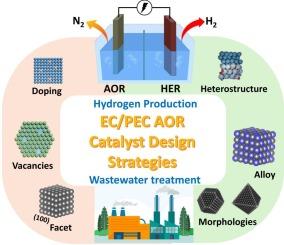为高效氨氧化制氢和废水处理定制电化学驱动催化剂中的原子种类
IF 5.9
3区 工程技术
Q1 CHEMISTRY, MULTIDISCIPLINARY
Journal of Industrial and Engineering Chemistry
Pub Date : 2025-06-02
DOI:10.1016/j.jiec.2025.06.003
引用次数: 0
摘要
发展清洁能源技术,解决能源危机、化石燃料过度消耗所造成的环境问题,以及由此产生的二氧化碳排放,已成为现代社会一项关键而紧迫的任务。电化学(EC)和光电化学(PEC)氨氧化由于其在环境条件下具有制氢和含氨废水处理的潜力而成为有前途的环保策略。然而,大多数氨分裂系统面临着与电催化氨氧化反应(AOR)相关的重大挑战,包括反应动力学缓慢,导致高过电位,电池效率降低和催化剂失活,从而限制了其实际工业应用。开发高效、可持续、低成本的AOR催化剂对于提高反应动力学和整体效率至关重要。在本文中,我们首先概述了AOR的基本原理和影响其性能的关键参数。其次,我们系统地总结和讨论了实现高AOR活性的电化学和光电化学方法的最新进展。最后,提出了合理设计和开发用于实际应用的活性、耐用AOR催化剂的挑战和未来展望。本文章由计算机程序翻译,如有差异,请以英文原文为准。

Tailoring atomic species in electrochemical-driven catalysts for efficient ammonia oxidation toward hydrogen production and wastewater treatment
The development of clean energy technologies to address the energy crisis, the environmental issues caused by excessive fossil fuel consumption, and the resulting CO2 emissions has become a critical and urgent task of modern society. Electrochemical (EC) and photoelectrochemical (PEC) ammonia oxidation have emerged as promising environmentally benign strategies due to its potential for hydrogen production and ammonia-containing wastewater treatment under ambient conditions. However, most ammonia splitting systems face significant challenges related to electrocatalytic ammonia oxidation reaction (AOR), including sluggish reaction kinetics, which lead to high overpotential, reduced cell efficiency, and catalyst deactivation, thereby limiting its practical industrial applications. The development of efficient, sustainable, and low-cost catalysts for the AOR is crucial for enhancing the reaction kinetics and overall efficiency. In this review, we first outlined the fundamental principles of the AOR and the key parameters influencing its performance. Second, we systematically summarized and discussed recent advances in electrochemical and photoelectrochemical approaches for achieving high AOR activity. Finally, the remaining challenges and future perspectives on the rational design and development of active, durable AOR catalysts for practical applications were proposed.
求助全文
通过发布文献求助,成功后即可免费获取论文全文。
去求助
来源期刊
CiteScore
10.40
自引率
6.60%
发文量
639
审稿时长
29 days
期刊介绍:
Journal of Industrial and Engineering Chemistry is published monthly in English by the Korean Society of Industrial and Engineering Chemistry. JIEC brings together multidisciplinary interests in one journal and is to disseminate information on all aspects of research and development in industrial and engineering chemistry. Contributions in the form of research articles, short communications, notes and reviews are considered for publication. The editors welcome original contributions that have not been and are not to be published elsewhere. Instruction to authors and a manuscript submissions form are printed at the end of each issue. Bulk reprints of individual articles can be ordered. This publication is partially supported by Korea Research Foundation and the Korean Federation of Science and Technology Societies.

 求助内容:
求助内容: 应助结果提醒方式:
应助结果提醒方式:


